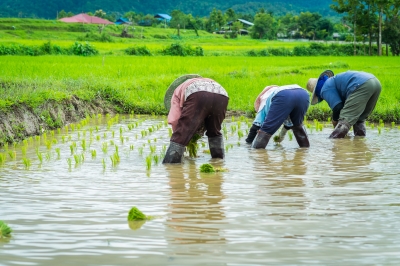Contract farming is halfway between vertical integration and spot market (financial instruments or commodities are traded for immediate delivery). It implies a double commitment:
– The farmer commits himself to produce according to the buyers need
– The buyer commits himself to honor is promises of giving support to the farmer (usually by investing in training and equipment)
This method allows the company to participate (and to inspect/control) to the process of production without possessing or having to manage the farms, the work force or organizing the production. It allows the farmers to stabilize their yields; to keep the ownership of there land; to reduce the relative risks of production ; to obtain supplies, a technical support and an access to the market ; to improve production.

Image courtesy of moggara12 / FreeDigitalPhotos.net
|
Benefits |
Drawbacks |
|
|
Farmers |
– Market access,
– Reduction in the risk of price fluctuations, – Increased incomes, – Credit, – Timely inputs, – Monitoring & labor incentives, – Reduction of production risks, – Introduction of high value crops. |
– Indebtedness,
– Monopsony control, – Higher vulnerability, – Labor management burden (recruitment and control) – Contract enforcement, – Production risk (new crops).
|
|
Investors Firms |
– Improve cost efficiency and minimize risk,
– Quality consistency, – Facilitation of trade standard requirements – Political Acceptability. |
– Increased risk (prices, crop failure),
– Contract enforcement (side-selling, using the inputs for other crops, inability to pay back the credit); – High transaction costs cf. large number of dispersed farmers. |
In Laos, contract farming is governed by the Law on contracts from 1990. It elaborates on the general specification to follow (duration, ending date, quality, price); obligation of results and mutual information; penalties for failure to abide by the terms of the contract; arbitration in case of conflict; conditions for changes in the contract, termination of the contract. Contract farming implies an investor and a farmer, villages or organisations of producers. It can also imply a intermediary (chief of village, other producer, harvester, etc.) in charge of negotiating the contract, of transmitting information or of the collect of the production.
Different combinations of resources can be offered to the farmers: provision of inputs (seeds, agrochemicals), credit, extension. Local authorities play an important role (facilitation, contract management, technical support), esp. in isolated areas where farmers have little experience.
|
Types |
Terre |
Travail |
Capital |
Marché |
Technologie |
Profit* |
|
2+3 |
P |
P |
E |
E |
E |
60-70% |
|
1+4 |
P |
P/E |
E |
E |
E |
30% |
Notes : P = Producer ; E = Enterprise
* Percentage of the crop / the sales that goes to the producer
- 2+3: The farmer supplies the land and the labor, the investor supplies the capital (seeds, fertilizers, equipment), technology and market access. Farmer must sell all his production to the buyer and receives 50-70% of profits. Contracts may last up to 30-35 years. This is currently the solution considered by Khepri
- 1+4: the farmer brings land and works for a salary (wage worker on his own land). Investor pays for all activities before the sharing of the rubber (7-8 years). The land or the trees are then shared with the farmers. Farmer must sell his rubber to the investor at market prices.
